Maeroa Intermediate School has been actively restoring their gully since October 2020 and what a difference they have made!

Before the weeds were cleared in 2020.
September 2020 was the first time students had been allowed in the gully in decades. It had become overrun with weeds and there were concerns that the existing tōtara trees, smothered with weeds like ivy and mignonette vine, could die and leading to further erosion of the gully banks.
Gully restoration was seen as an opportunity for learning and action involving the whole school whilst enhancing the natural biodiversity of the area.
After talking with of local gully experts, and exploring alternatives, the school came up with a vision for the gully that included an outdoor classroom space for students, planting appropriate native trees, controlling erosion, creating habitats for a wide range of native wildlife and improving the water quality of the stream.
The school had had its back to its gully for decades, but in 2019, when Maeroa staff and students, with the support from the national Enviroschools team had a deep dive into a Healthy Homes inquiry, this all changed. As part of this learning the students looked at ‘nature as our first home’ and four classes had an immersive full day trip to Sanctuary Mountain – Maungatautari. Teachers and students were so inspired, they came back to school realising they this enormous opportunity and action project right on their doorstep. They had built an awareness of the possibilities and they wanted to get stuck in!
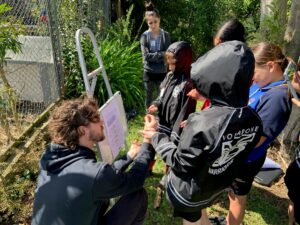
An experiential activity with community expert, Matt Noble, River Management Lead, WRC, helped students build an understanding of their gully ecosystem.

One way of measuring stream health is to check presence, observe and identify the macroinvertabrates. Alicia Williams, Senior Environmental Officer, WRC helps students.
With the support of the Principal, Board of Trustees, and Caretaker, and engaging with local experts during the 2020 lockdown, some of invasive weeds were dealt with. In September 2020 Waikato Regional Council staff with the support of Enviroschools Facilitator, Adrienne Grant, ran workshops for students about gullies, water quality and restoration to build knowledge, awareness and enthusiasm.

A community working bee making trapping tunnels.
Key teachers Julie Yeoman, Oriana Tauranga and Lizzie McKenzie have since led after-school and monthly working bees that have helped with the ongoing transformation of the gully. Between 10-20 students turn up every Tuesday and Thursday after school to help with various tasks like weeding, planting and looking after the seedlings in the nursery. Once a month there is a community working bee on a Saturday morning. Students, their parents and other members from the local community come along to help out. The very first Saturday Working Bee in October 2020 had 15 people, the last one in September 2021 had 45 volunteers.
A monthly newsletter is written and emailed out to supporters, as well as dropped in the letter boxes of the local community by students. This is part of keeping everybody informed of what is going and has helped to build momentum.
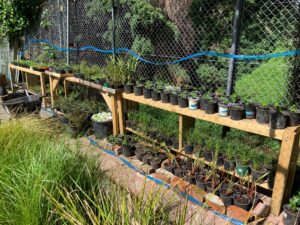
Seedlings and cuttings of various species and development growing in the sschool nursery.
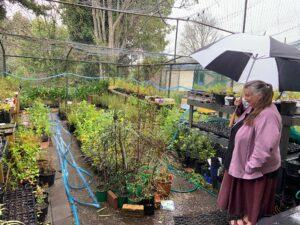
Key teacher, Julie, checks out the school nursery. No need for watering today!
While tackling the weeds was the top priority, the students and teachers knew that part of the process of restoration was to plant indigenous plant species. A nursery was set up so the students could propagate their own seedlings. Adrienne got students started with eco-sourcing mānuka, karamū and māhoe seed, and teacher Julie and other members of the community have since helped source seeds and plants. Part of undertaking any restoration is funding and the school has been lucky to receive funding from Matariki Tu Rākau, a community tree planting programme managed by Te Uru Rākau – New Zealand Forest Service, who created the video below of the gully project.
Funding has also been received from Waikato Catchment Ecological Enhancement Trust (WCEET). Waikato Predator Free Hamilton have been advising the school on setting up trap lines through the gully to control rats and possums, and a large number of trap boxes are ready to be set out. Waikato Regional Council have helped fund remedial work to open and stabilise the stream channel.
Maeroa students are now regularly giving tours of the gully to teachers and students from other schools. Community members are coming forward with donations of plants and asking for ways to help and members from the wider community are coming along to help on Saturday mornings because they want to be involved in such a positive and meaningful project.
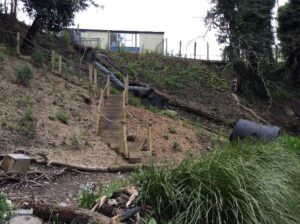
What a difference 2 years of hard mahi makes.
As a way to show change and progress in the gully, the school is having eight ‘before and after’ photos printed on to metal signs which will placed in situ in the gully. It will be a very powerful way of showing the progress that has been made.
When Maeroa Intermediate School students, teachers and community reflected at Enviroschools silver level in 2021, they identified several next steps for their gully project.
Maeroa Intermediate School Gully next steps ideas to explore:
- Investigate route of gully stream. Where does it drain? Hikoi to explore stream network.
- Create a photo book of gully progress to share with future kaitiaki.
- Investigate canal plans for gully restoration.
- Inquiry into pest trapping in gully.
- Do a stock take before planting. Statistics will be helpful/interesting for school funders.
- Do some media stories to promote the gully.
- Water quality in gully stream- investigating and collecting data.
- Encourage the wider community to get involved in the gully working bees e.g. connect with local iwi groups.
- Create mini terraces when planting on the steep slopes to reduce erosion.
“The kids are learning all the time – like how the planting of native plants creates habitat for our native wildlife and helps control erosion to improve water quality. We even have a school nursery now where the kids grow their own plants from eco-sourced mānuka, karamū and māhoe seeds.” – Key teacher Julie Yeoman
This legacy project commemorates a wonderful member of the school community, provides meaningful engagement for current students and their community and will contribute to a healthy and bio-diverse Maeroa ecosystem.
“I like seeing all the change that is happening and we get to explore at the end of the working bees. Seeing the eel was pretty cool – it was the first time we’d seen one at school. It was about 50cm long. We just kept starring at it for ages.” Zoe, Year 7
The most recent workshop saw 38 community members gather for a mega mission to control weeds. This was the first since early in the year because of Covid 19 restrictions. Weeds had flourished so these were cleared before laying jute weed mat prior to winter planting.
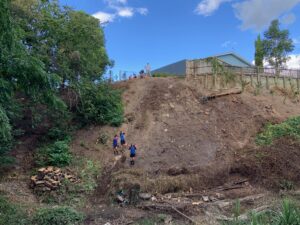
A patch of bank is cleared of weeds and ready for matting and planting.
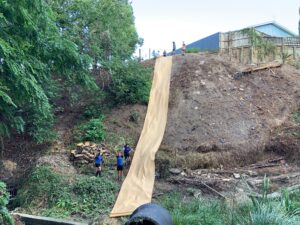
One long piece of weedmatting cascades down the hill!
An article written by Waikato Regional Council about this project can be read here.
You can also read about Tradescantia weed bio-control measures and monitoring in an article here.
